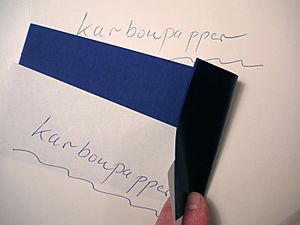Carbon copy facts for kids
A carbon copy is a duplicate of a document made at the same time as the original. Imagine you're writing a letter, and you want to keep an exact copy for yourself without writing it all out again. That's where carbon paper came in handy! It allowed people to create two or more copies of something like a letter, invoice, or receipt, all at once.
Contents
What is a Carbon Copy?
A carbon copy is made using a special sheet called carbon paper. This paper has a dark, inky coating on one side. When you place it between two regular sheets of paper and then write or type on the top sheet, the pressure from your pen, pencil, or typewriter key transfers the ink from the carbon paper onto the second sheet below. This creates an exact duplicate of what you wrote on the top sheet.
How Did They Work?
To make a carbon copy, you would stack your papers in a specific order:
- First, the top sheet of paper (this would be your original document).
- Next, a sheet of carbon paper, with its inky side facing down towards the next sheet.
- Then, the second sheet of paper (this would become your copy).
- You could even add more layers of carbon paper and regular paper to make multiple copies!
When you wrote or typed on the very top sheet, the pressure pushed the ink from the carbon paper onto the sheet below it, creating the copy. It was a simple and effective way to get instant duplicates before photocopiers were common.
A Bit of History
Carbon paper was first invented in 1806 by an Englishman named Ralph Wedgwood. He created it to help blind people write without ink, but it quickly became popular for making copies. For over a century, carbon copies were the main way businesses and individuals made duplicates of important documents. Before computers and printers, offices relied heavily on typewriters and carbon paper to keep records and send copies of letters. It was a very important tool for communication and record-keeping in the 19th and 20th centuries.
"CC" in the Digital Age
Even though we don't use physical carbon paper much anymore, the idea of a carbon copy lives on in the digital world. When you send an email, you often see a "Cc" field. "Cc" stands for "carbon copy." When you put someone's email address in the "Cc" field, it means they will receive a copy of the email, just like the original recipient. Everyone who receives the email can see who else received a "Cc" copy. It's a way to keep people informed without them being the main person the email is for.
Why Don't We Use Them Much Now?
The use of physical carbon copies has greatly decreased over time. This is mainly because of new technologies that make copying much easier and cleaner.
- Photocopiers: Machines that can quickly make many copies of a document.
- Printers: Connected to computers, they can print multiple copies of digital files.
- Digital documents: Files on computers or the internet can be easily shared and duplicated without needing paper at all.
These modern methods are faster, cleaner, and more efficient than using carbon paper. However, the term "carbon copy" and its abbreviation "Cc" remain a part of our language, reminding us of how things used to be done!
See also
- In Spanish: Copia de carbón para niños


